Cuban Health 11
Taking care of my health, and yours

Taking care of my health, I take care of yours
People over 59 years old and children under one year old are essentially symptomatic, but the rest can carry the disease without being suspected. That is why it is vital to respect to the letter the established biosecurity norms
Author:

Ana María Domínguez Cruz
anamaria@juventudrebelde.cu
Translated and edited by Walter Lippmann for CubaNews.
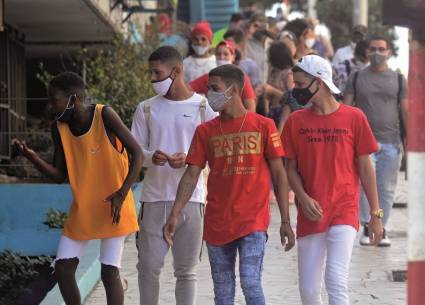
Young people are the ones who most often transit as asymptomatic. Author: Abel Rojas Barallobre Published: 19/01/2021 | 12:03 am
Where were you? Who did you meet? These and many other questions make up the survey that, with rigor and specificity, is carried out on each person who, confirmed as positive to COVID-19 or as a suspect, arrives at a hospital in our country.
It seems routine, but it can be very overwhelming, both for the patient, who suffers from that indescribable mixture of fear, uncertainty and anxiety; and for the health personnel who, with the required clothing, approach him/her without wanting to violate the health protocols, although with the desire to make him/her feel better.
This is what Niurka Molina Aguila, a specialist in II degree in Hygiene and Epidemiology, tells us, who carried out numerous surveys of this type as part of her work at the Pedro Kourí Institute of Tropical Medicine (IPK).
“Do you know what is the most important and, at the same time, most overwhelming, especially for the patient? It is necessary to answer these questions by appealing to the memory as accurately as possible because it is urgent that the answers refer to the 14 days prior to detection. This is the only way we can properly follow the transmission chain,” she assures us.
It is hard to imagine, but this is the day-to-day work of epidemiologists and other specialists who have been working for months in the midst of a scenario as hostile as the one imposed by COVID-19 on the world.
“The greatest danger of this disease lies not only in the very act of suffering it, but in asymptomatic people who, precisely because they do not feel anything that alarms them, carry out their usual activities and have contact with others, and become carriers with the same risk of transmission as those who do manifest the symptoms.
“Who are these asymptomatic people? You, me, that one, her…, but fundamentally the young people. People over 59 years and children under one year are essentially symptomatic, the rest, adolescents, young people and adults of less age, can carry the disease without suspicion. Til/khat is why it is vital to respect to the letter the established biosecurity norms”.
I do not feel, but I suffer
Based on research carried out at the IPK since last year (which has not been published), when cases of the disease began to be reported in the country, it has been assessed during all this time that about 63 percent of the people identified as positive were asymptomatic. This figure, logically, increases as contact searches are carried out through active surveillance, that is, through research.
The also Master in Infectious Diseases specifies that this study covered Havana, fundamentally, but it will continue to evaluate the results according to a better work of prevention and control of COVID-19. “The disease has been known gradually, as people have become sick.
“Much is still unknown, and so describing symptoms is complex. We already see that sometimes the loss of taste and smell are the only symptoms, even, of the disease. Until it was proven in several patients, it could not be described as an associated symptomatology, and this has happened with other aspects.
“The main thing is to respect the established sanitary norms. We cannot get tired of repeating them and enforcing them, because it is the only way we have to make it clear that this disease will not disappear completely, but rather that we will live with it as a seasonal disease, like H1N1 or others.
-Even if they are asymptomatic, can these people suffer from the sequelae of the disease?
-Yes, it is possible. The sequelae left by COVID-19 have already been described in healthy people who suffered from it. Having symptoms or not, does not necessarily condition the appearance of the sequelae, but when in doubt it is better to avoid contagion.
-The vaccine is the hope…
-Because of our human condition, we need hope to move forward. Certainly, we are anxiously waiting for the vaccine, but the population must know that every vaccine has a time to raise the immunity of the organism. That we vaccinate ourselves today does not mean that tomorrow we are already immune to the virus, especially when new strains are reported from time to time.
“There are vaccines that require two doses, and completing the cycle is essential. However, from the appearance of new strains, it is preferred in not few cases to delay the application of the second dose, and this prolongs the immunization process”.
The doctor, also researcher and assistant professor, underlined that until there is not a high number, very high of vaccinated and immunized people, one will not be out of the greatest danger and never absent completely.
The Cuban population must be informed and correctly oriented, based on the results of the researches carried out and the patients’ reactions when they receive the vaccine.
“I do not intend to alarm, but it must be taken into consideration that another new strain of the virus may emerge and the vaccine may not have the capacity to face it, so it will be necessary to continue studying and creating.
“The health measures that are so much repeated today in the different media are for life, because from now on the world will no longer be the same as the one we knew before the pandemic.
“The family must insist on their children and demand that they respect these measures, because one of the greatest dangers of this pandemic is that health services will collapse, as has happened in other nations. Not only do they collapse because people get sick, but because they don’t avoid getting sick.
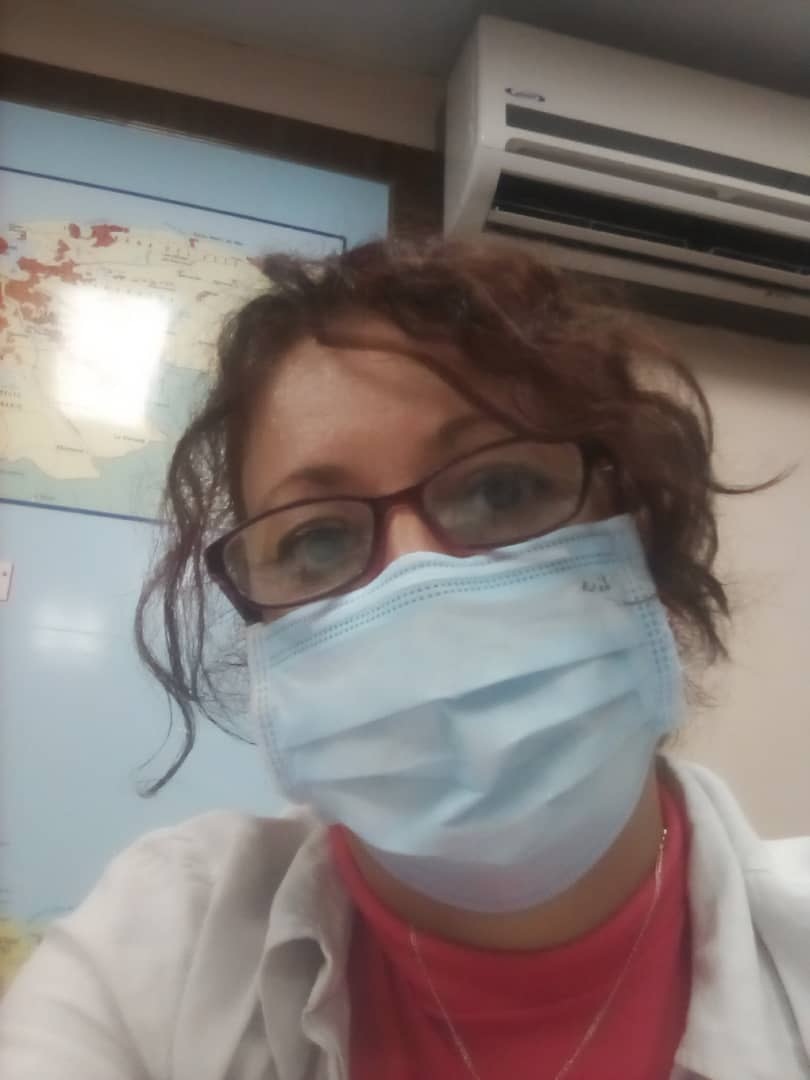
Niurka Molina Aguila, specialist in II degree in Hygiene and Epidemiology, researcher at the Pedro Kourí Institute of Tropical Medicine Photo: Courtesy of the interviewee
Molina Águila also mentioned the process of surrendering patients as convalescents. “Many times it is the time to complete the questionnaire that, when they first arrived at the institution, they could not continue with its completion”.
She emphasized that we should not go to closed places or places where crowds predominate, that the nasobuco should be worn correctly, that frequent hand washing should be deep, that when coughing or sneezing we should protect ourselves with our forearms, that we should maintain distance between one person and another.
“You, me, him, her… any one of us can transmit the disease without knowing it, and that’s what you have to understand. To the extent that someone who lives with other people takes better care of their health, their love and integrity cannot be questioned. These are not times to love as in the old days, but to demonstrate that by taking care of our life, we take care of the lives of others.
A Frenchman Who Saw the Sun Again

The Frenchman Who Saw the Sun Again in the Isolation Center in Matanzas
This white-bearded man conveys with his clear eyes the immense gratitude that neither resources nor tiredness nor sleep were spared in order to save him
 By Hugo Garcia digital@juventudrebelde.cu
By Hugo Garcia digital@juventudrebelde.cu
April 9, 2020
Translated and edited by Walter Lippmann for CubaNews.
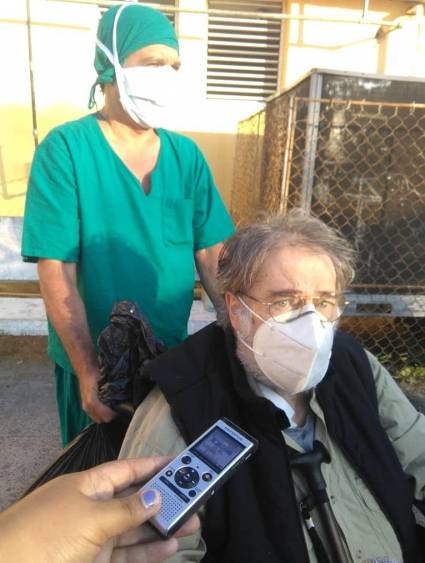
Jack Gaetan Joseph Villiers, Discharged Patient Author: Jessica Rufin Posted: 09/04/2020 | 07:36 pm
Jack Gaetan Joseph Villiers is a Frenchman who is miraculously alive. It’s as simple as that. But the miracle has also come about because of the proven professionalism of Cuban health.
“This is the first time I’ve seen the blue of the sky after almost 20 days of admission,” he said in a choppy voice from the wheelchair in which he was being transferred to the ambulance that would take him to Havana.
This man with a graying beard conveys with his clear eyes the immense gratitude that no resources, no tiredness, no sleep were spared to save him.
“But I feel good already. When all this is over, we will return to Cuba,” he whispered in his deficient Spanish as he said goodbye to the bus at the Mario Muñoz Monroy Hospital’s isolation center, becoming the sixth confirmed positive patient of the COVID-19 to be discharged in this city.
“Now I can confirm what my brother, who is a doctor, said about the capacity of Cuban doctors, who have specialized in fighting pandemics and diseases like these,” the Frenchman stressed to the Matanzas television and radio media.
Dr. Juan Carlos Martin Tirado, director of the hospital, confirms that this is another achievement of Cuban medicine, because this patient had many of the expected complications at his 72 years of age, including heart disease, hypertension and a major underlying diabetes mellitus.
Martín Tirado praised the delivery of the multidisciplinary team of intensive care, which worked day and night to save the patient.
Brave Ones: Revealing Faces, Beatriz

BRAVE ONES: Revealing Faces, Beatriz Rodríguez
April 12, 2020
Translated and edited by Walter Lippmann for CubaNews.
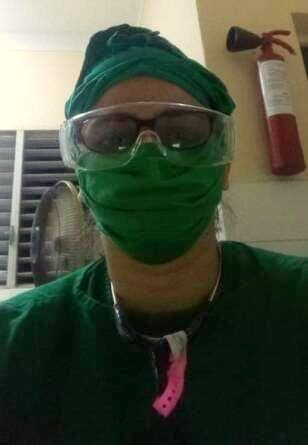
Beatriz Rodriguez Sandeliz is 30 years old. She is a First Grade Specialist in Pediatrics and head of the Respiratory Service of the Children’s Hospital “José Luis Miranda”, in Santa Clara, Villa Clara. Dr. Beatriz formed, in the beginning, together with Dr. Marbin Machado Díaz, also from the Children’s Hospital and Drs. Lissy Pérez Leal and Richard Godoy León, from the “Manuel Fajardo” Military Hospital, the team of eight pediatricians who, at present, attend to infants who are contacts, suspects or infected with the SARS-CoV-2 coronavirus.
“If they knew how hard it is to see a 12-year-old girl crying because her PCR has tested positive, we wouldn’t be so irresponsible and would stay home. It hurts to see a helpless child cry because we have not been consistent and have failed to protect those who are the hope of the world,” says this young doctor with only six years of training, three of them as a pediatrician.
(Texts and photos by Yudith María Delgado Rodríguez and Félix Alexis Correa Álvarez)
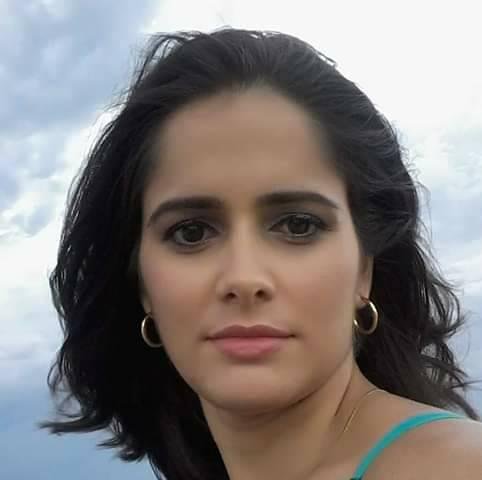
Does Panic Help in Pandemic Situations?

Covid-19:
Does Panic Help in Pandemic Situations?
By Danay Galletti Hernández
March 24, 2020
Translated and edited by Walter Lippmann for CubaNews.
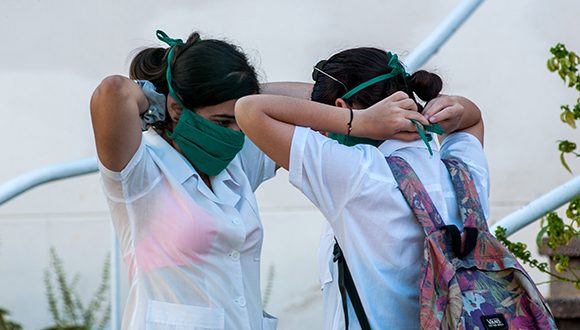
Medical students during the investigation of COVID-19. Photo: Abel Padrón Padilla/Cubadebate
Hysteria is as dangerous as social apathy, said Dr. Annia Duany, head of the Psychiatry Group at the Hospital Docente Clínico Quirúrgico Salvador Allende in Cuba, She said that confidence in the social measures taken in Cuba against COVID-19 is essential.
Panic does not help in pandemic situations and a favorable mood affects the prevention and treatment of diseases, Dr. Duany told Prensa Latina.
“It’s normal in this situation for people to experience nervousness, worry, anxiety and fear, but it’s essential to have positive coping resources. Examples being with family, seeking reliable and safe information, doing tasks and enriching our spiritual world,” he said.
On the other hand, Dr. Ana Sarracent, head of the Psychiatry Group at the Calixto Garcia Hospital, explained that although there is a risk of contagion at any age, epidemiological research indicates that those over 60 are more vulnerable to Covid-19.
“In these cases, family support is transcendental because they are more sensitive from the psychological and organic point of view. Also, extreme care and hygiene must be taken, as well as those with nervous or cognitive disorders, to ensure that they enjoy positive and happy materials,” she said.
The research work implemented to identify flu symptoms in the population and possible cases of the pandemic also reveals a significant number of adults who live alone and, therefore, need community support, Sarracent added.
They tend to have a hypochondriacal view of diseases and their situation of loneliness, as well as a diverse perception of the news broadcast on the subject, he said.
In coming days, numerous Cuban residents will arrive in the Caribbean nation and will be under isolation in response to a protection measure. The family, far from being distressed or depressed, must be aware and assume it in an appropriate manner, he said in reference to the most recent measures taken by the authorities.
About the children and how they should be treated in this context, Dr. Mabel Whilby, head of the Infant-Juvenile Group at the Pediatric Teaching Hospital of Cerro, Havana, explained that this sector of the population has different stages in psychological development and should receive information age appropriately.
The family must convey to the children that this situation will soon return to normal and then they will be able to play again with their friends, she said.
Children also have emotions, sadness and fears and must channel them, and at the same time, their parents must instill security and confidence in them through play, she added.
In this sense, conversations between adults cannot take place in front of children because they are too aware of the signs of how adults handle this situation, as they are patterns to imitate.
The specialists agreed on the importance of risk perception and insist that isolation and surveillance in homes be assumed with appropriate behavior: avoiding alcoholic beverages, smoking or neglecting eating habits.
Questions and rumors about COVID-19
Thanks to Cuba, I Came Back to Life


First Cuban Coronavirus Carrier:
“Thanks to Cuba, I Came Back to Life”
Jesús Álvarez, who has been discharged, said he had the strength to resist in the middle of the storm, because he knew about the quality of Cuban medicine
Author: Freddy Pérez Cabrera | internet@granma.cu
Translated and edited by Walter Lippmann for CubaNews.
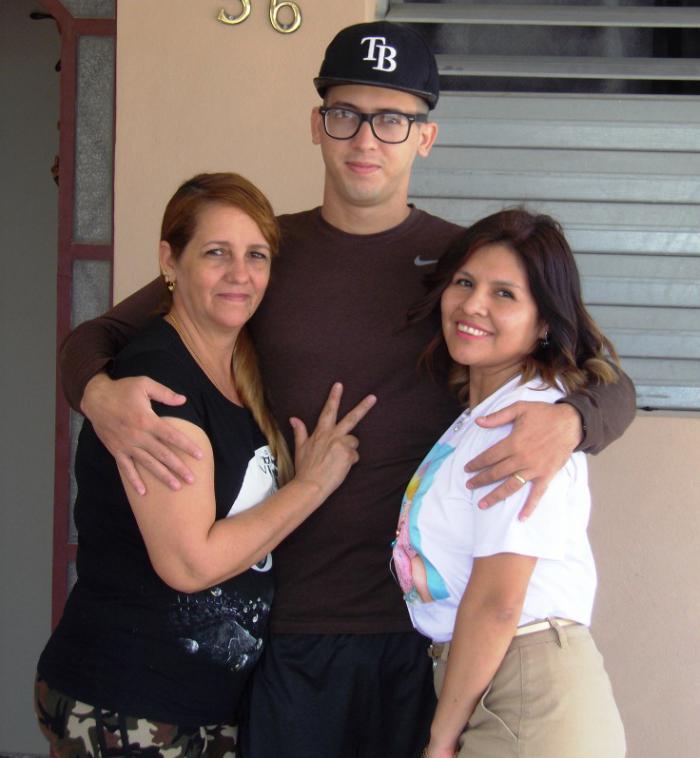
Jesús Álvarez López, the first Cuban carrier of the COVID-19, with his mother Irania López Aldama and his wife, the Bolivian living in Italy, Anel González Zurita. Photo: Freddy Pérez Cabrera
Santa Clara – I do not have words to express my gratitude to Cuba, which has been able to train such humane and professional doctors, nurses and specialists, thanks to whom I am back to life today, said Jesus Alvarez Lopez, the first Cuban carrier of the new coronavirus who has been discharged.
The 25-year-old dancer, who lives in this city, told Granma that at present he is evolving very favorably, and with a very rigorous follow-up by the family doctor, who comes daily to see how he is doing, takes his temperature and performs other controls, according to the protocols established for these cases.
About the experience, he said that his wife, Anel González Zurita, a Bolivian citizen living in Milan, Lombardy region, Italy, had arrived in Cuba without any apparent symptoms of any illness. However, a few days later she began to have slight respiratory problems, as he did. For that reason they went to the health system, where they were immediately admitted to the Villa Clara isolation hospital, and later transferred to the Pedro Kourí Institute of Tropical Medicine (IPK), where the illness was confirmed.
“Imagine what I suffered at that moment; the world fell on me. I felt fear, I thought the worst, in my family, in my little girl Ana Sofía who was only one year old. But I had the strength to resist in the middle of the storm, because I knew about the quality of Cuban medicine,” says Alvarez Lopez.
Referring to the treatment he received, he has words of praise for the doctors and all the staff who work at the Manuel Piti Fajardo Hospital in Villa Clara and the IPK, for which he says he feels grateful. They made him understand that he was not alone during those days of isolation. “They were my parents, my brothers, my friends,” the young man said emotionally.
“There I lacked for nothing, no medicine, no resources of any kind. They even spoiled me a little bit, because if I was hungry, it didn’t matter if it was two in the morning, they brought yogurt or some food. If I wanted to talk to my family, they facilitated the conversation through the telephone. In short, I was pleased with everything, says Jesus, who before saying goodbye, wanted to send a message to the Cuban people, whom he thanked for so much love in these difficult days.
“I am worried because I see some people who are still on the streets and without the necessary consciousness for the present situation. To them I say to take care, that this can touch anyone. You have to listen to the guidelines of the government, which is working very hard to avoid the worst. If we take all the measures, we will get out of this, because we are a people of battle, nobody doubts that, we will win.
Against the Coronavirus, Count on Cuba
Against the Coronavirus, Count on Cuba
By Jorge Gómez Barata
March 18, 2020
Translated and edited by Walter Lippmann for CubaNews
I heard two appeals to the Cuban government yesterday. A brief and peremptory: “Close the airports: Now!” The other one sounds like a plea: “I ask the Cuban government please DO NOT to send our medical personnel anywhere…”
By the way, the Chinese authorities believe they have identified “patient zero.” He is a man who contracted the virus in mid-November 2019. Since then, more than 100 days, after which there are three sick people in Cuba, no dead, and about 150 contacts under medical supervision. why then close the airports?
The other fellow Cuban, asks that “no medical and nursing be sent anywhere…” The thing is, the government doesn’t send them. In any case, it summons trained professionals and in full use of their rights acting voluntarily. Probably, many take on the task not as a task, but as an opportunity. I know comrades, myself among them, who believe it was worthwhile to go Angola where the risks were enormous.
In December 2019, China was surprised by the aggressiveness of COVID-19, but not Europe and the United States. In fact, since the end of December 2019 and early March 2020, had more than 60 days to prepare. The warning was early, although the reaction turned out to be late. The alarm, at times a mixture of impotence and hysteria, is motivated not only by the explosive spread of COVID-19, but also by the ineffectiveness of health systems in responding to situations to guide social and economic activity. societies to observe minimum rules.
Cuba, with more than 100,000 doctors and sufficient nursing staff, more than 3000 hospital beds for that purpose, the means to diagnose and the necessary medicines and a national mobilization led by the president of the republic, manages the threat. It does this without demanding extraordinary sacrifices and costs from the population which they cannot incur.
Cuban solvency stems from having faced two major epidemics: African Swine Fever in 1980 and a sudden outbreak of Dengue Fever that 1981 affected more than 300,000 people, 158 of whom died. To study, participate in events or get cured, they come to the island by the thousands, people from poor countries and tropical climates where there are infectious diseases. Cubans, too, by the hundreds of thousands as happened in Angola, travel and stay in those countries. Rejecting some and preventing others from traveling is not part of Cuba’s national health doctrine.
Cuban solvency can be explained by the fact that for decades, thanks to the existence of an effective health model, based on a system of primary care, an advanced approach to the epidemiological issue [has been in place] It addresses the prevention and treatment of diseases like Dengue, Zika, Cholera, Chikunguya and others. Cuba’s strengths show that it is not always about money. From one day to the next some developed countries can have fifty billion dollars to deal with the pandemic. However, no amount of money will allow you to install national primary care and to have hospital capacities to deal with the COVID-19 crisis. Nor is it possible to inculcate all people, the habit of going to the doctor as the Cubans do, among other reasons, because none of them will leave in debt or broke.
The task of the moment, as the World Health Organization suggests, is to identify, isolate and cure the infected, and control rigorously their contacts. As for the tourists, people presumably healthy, checked in their countries and re-examined when you get to the island, there’s nothing to be afraid of. As it has always been done, those who arrive healthily will be cared for and those who unfortunately get sick, they’ll be cured. See you there.
Quarantined Physician Describes It

Quarantined
Holguinera doctor Yaritza Pérez Peña fought her first face-to-face battle with the Covid-19
By Germán Veloz Placencia
March 19, 2020
Translated and edited by Walter Lippmann for CubaNews.
I’m listening to Dr. Yaritza Perez Pena on the phone. Her voice sounds strange because she’s wearing a nasobuco [face mask]. I confess that I am anxiously looking for this contact and that she has more admirers behind her. I wish, I tell her, that from the Military Hospital of Holguin, where she is now in quarantine, she will share details of the moments in which, thinking of human beings, with her clear vision as a doctor, she fought her first face-to-face combat with the Covid-19.
“It was at the Hotel Rio de Oro, in the municipality of Rafael Freyre. She worked at the International Clinic of Guardalavaca and was on duty at the hotel’s Medical Post, where a Canadian guest arrived, at the suggestion of Mariluz Claro, the room’s waitress. She detected that the tourist had a cough, vomiting and diarrhea.
“Mariluz didn’t waste any time. She was alert and also warned her superiors about the case. This is what all the hotel staff was told to do when they trained staff to act at times like this. Together with nurse Marilín Oramas, I concluded that we were facing a suspicious case of the new coronavirus and we isolated it right there, to cut the chain of contacts with other people”.
She tells details about the operation of isolating the patient and his subsequent transfer to Villa El Cocal, in order to carry out the test expeditiously, which, sent to the Laboratory of Molecular Biology of the Provincial Center of Hygiene, Epidemiology, and Microbiology in Santiago de Cuba, proved positive.
Yaritza Pérez, since she was a student at the University of Medical Sciences of Holguín, has prepared herself to face contingencies like this, she assures us. Then in Brazil, during her second mission as a collaborator, she faced severe outbreaks of zika, dengue and malaria, and implemented well-designed medical protocols. But the new coronavirus has great contagious power and collective vigilance to detect cases and prevent their spread cannot be compromised, she says.
She says that in the 26 de Julio neighborhood in Rafael Freyre, her son, husband, parents and siblings are keeping an eye on their progress during the period of isolation, and that is great emotional support. She is also called by her colleagues at the clinic.
“Mariluz, Marilín and I remain asymptomatic, just like the rest of the people we contact with the patient. We will be isolated for about 14 days, which is the incubation time of Covid-19. We feel protected by the staff of the Military Hospital. They have been very gentle with everyone.
In hands like those of these names, the Cuban family is well protected. The best thing is that, throughout the island, there are thousands like them.
How to Make a Surgical Face Mask at Home

How to Make a Surgical Face Mask at Home
We also offer you some tips for its use
By Isairis Sosa Hernández isairis@juventudrebelde.cu
March 10, 2020
Translated and edited by Walter Lippmann for CubaNews.

One of its most common applications is when performing surgery, because the patient is exposed to any virus or contaminant. Author: Pinterest Published: 10/03/2020 | 05:34 pm
During this Monday’s special Round Table, where the measures adopted by Cuba to face the threat posed by the rapid and broad international expansion of the new coronavirus were reported, Cuban Prime Minister Manuel Marrero Cruz said that we can be concerned and concerned about the epidemic, but what we really have to do is prepare for an eventual entry of the virus into our country.
So, Así de Fácil wants to show you today how we can make a nasobuco or mask at home and offer you some advice on how to use it.
A piece of cloth and two pieces of elastic is what you will need to make this simple mask. Another model that we also propose, uses only fabric and does not use elastic, as they are usually worn in medical institutions. The images will show you every step.
As I always say, if you have children at home, encourage them to participate in the making of the mask so that they can enjoy how wonderful it is to create something with our own hands. See you next week to continue turning a simple idea into a great solution. Don’t miss out!
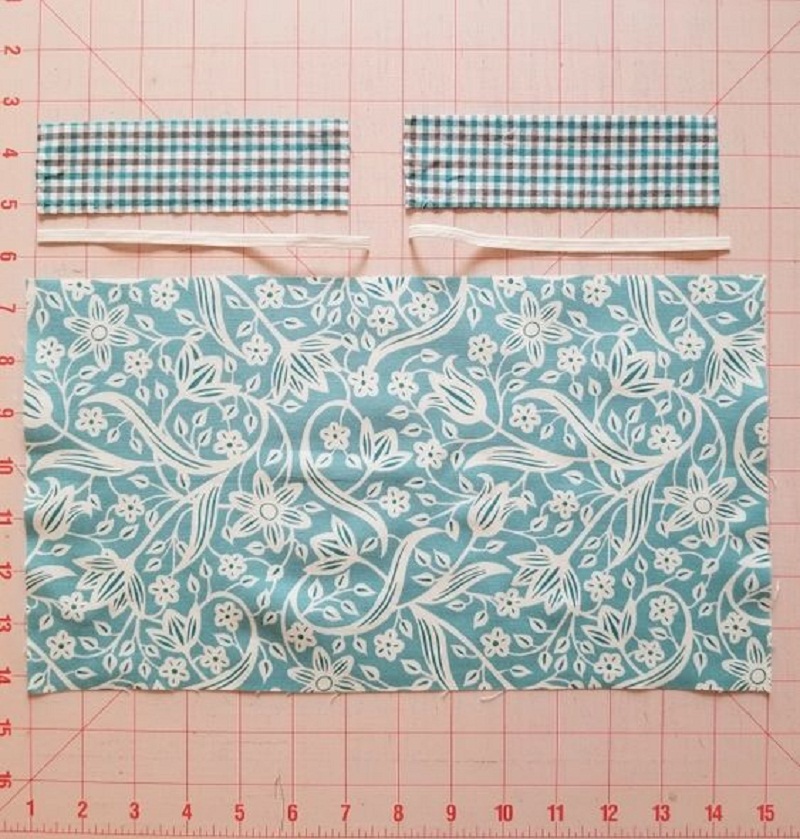
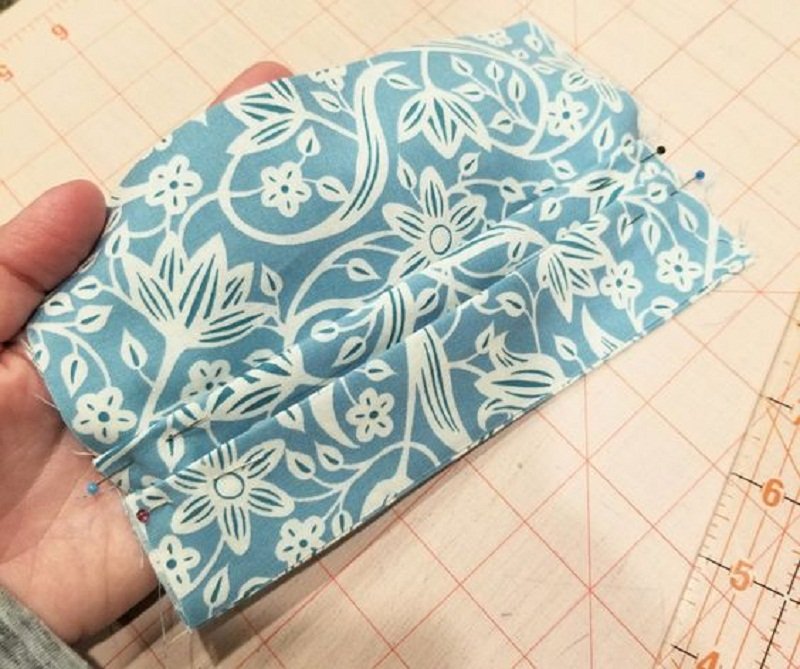
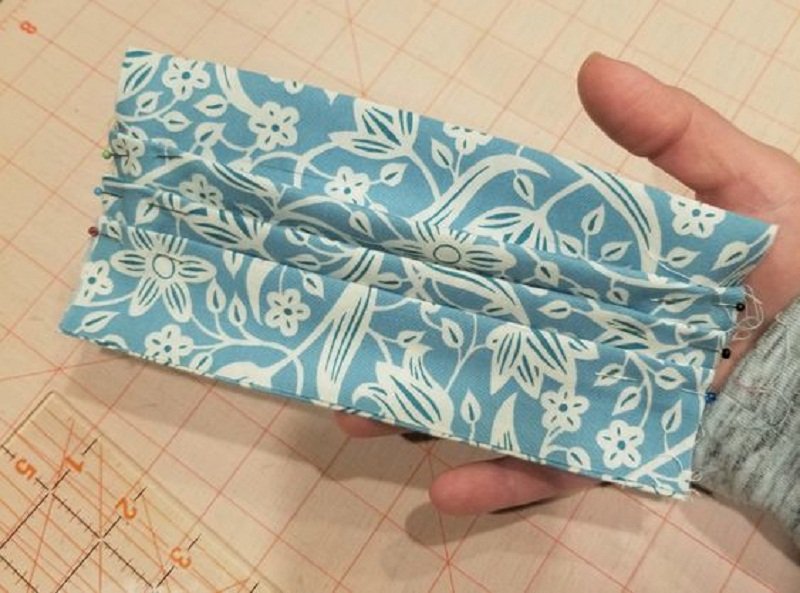
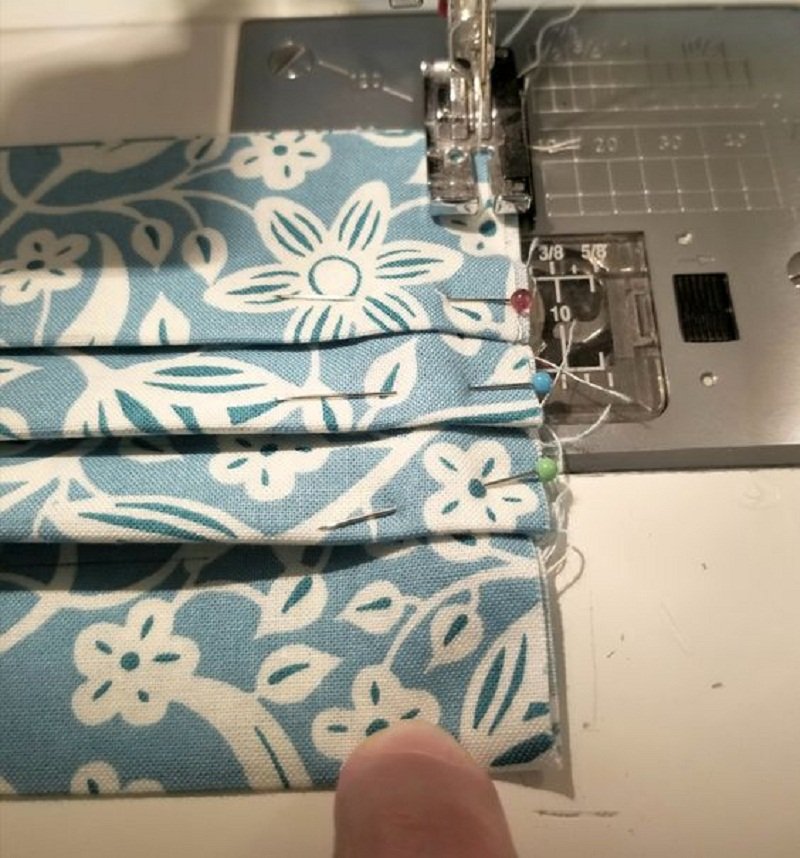
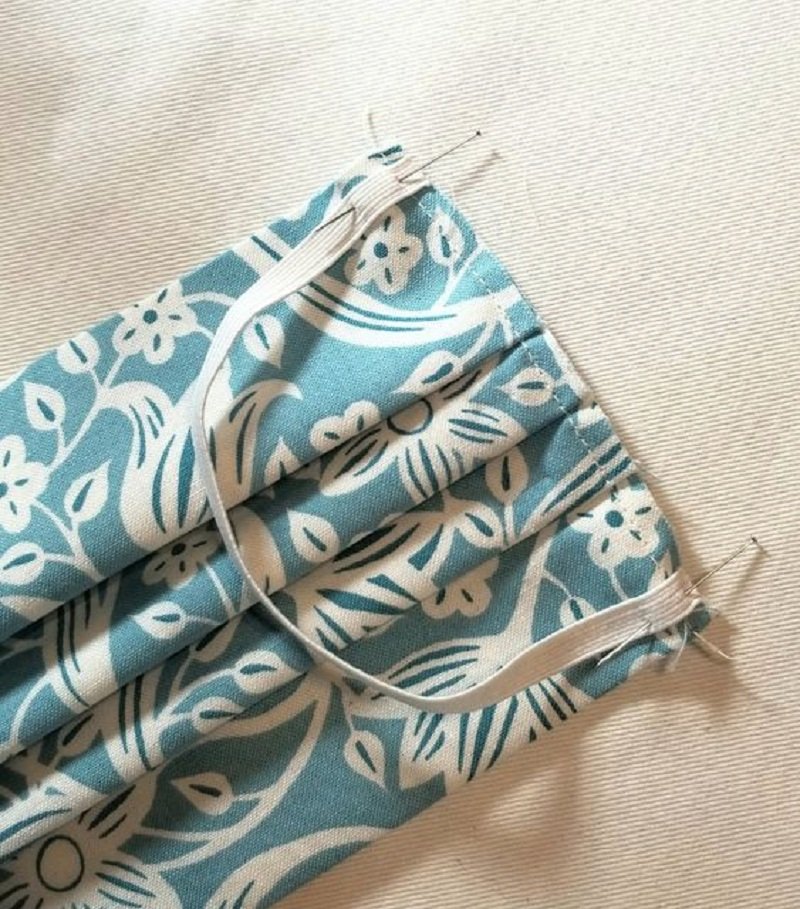
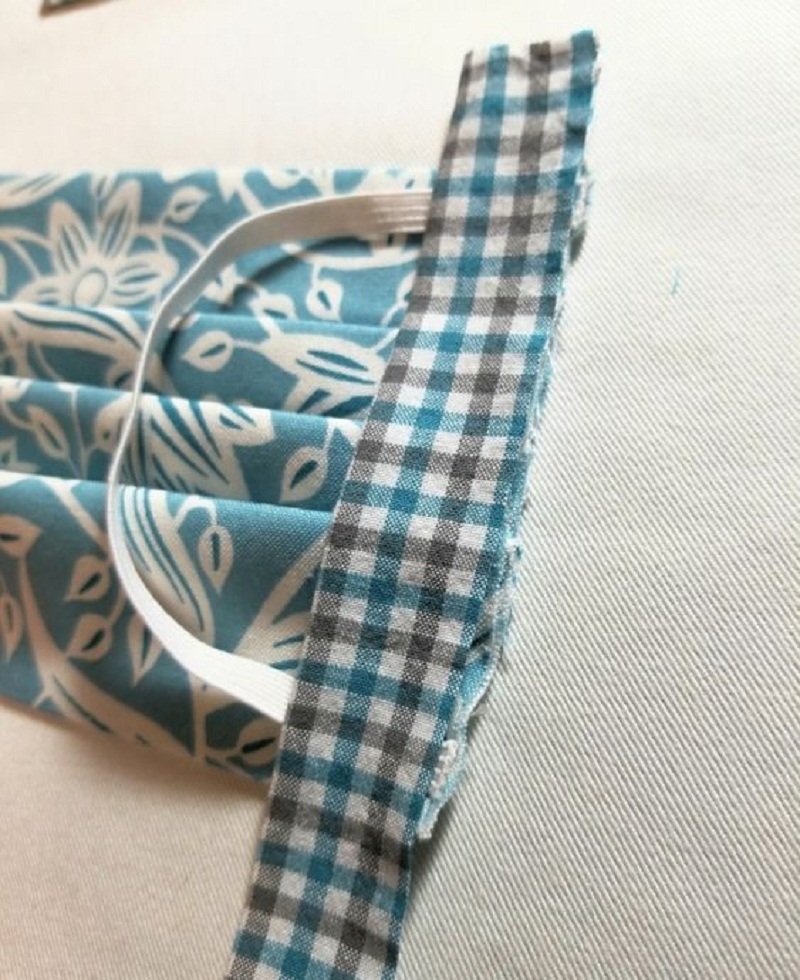
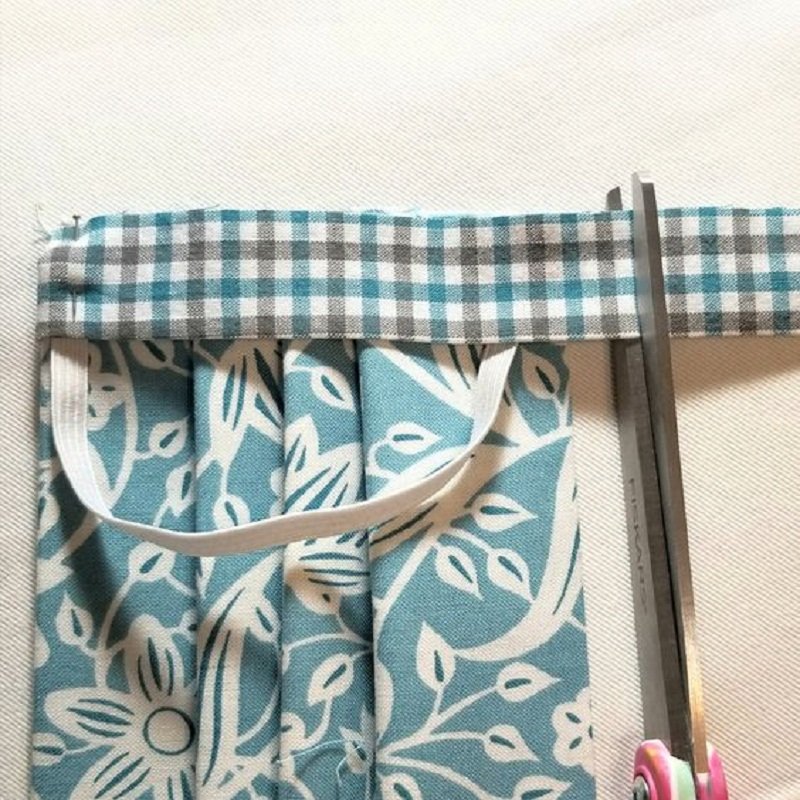
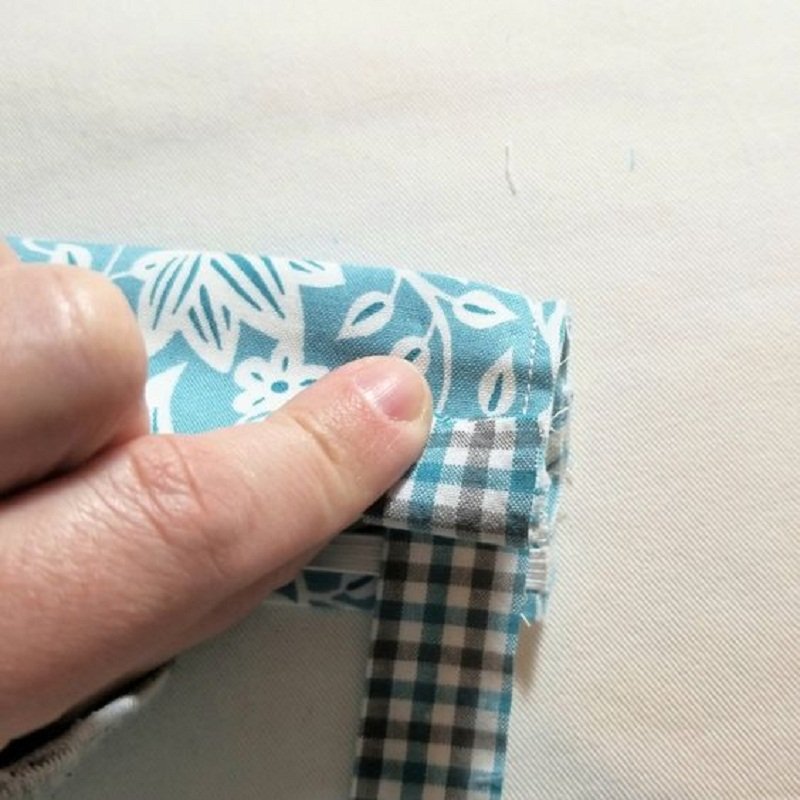
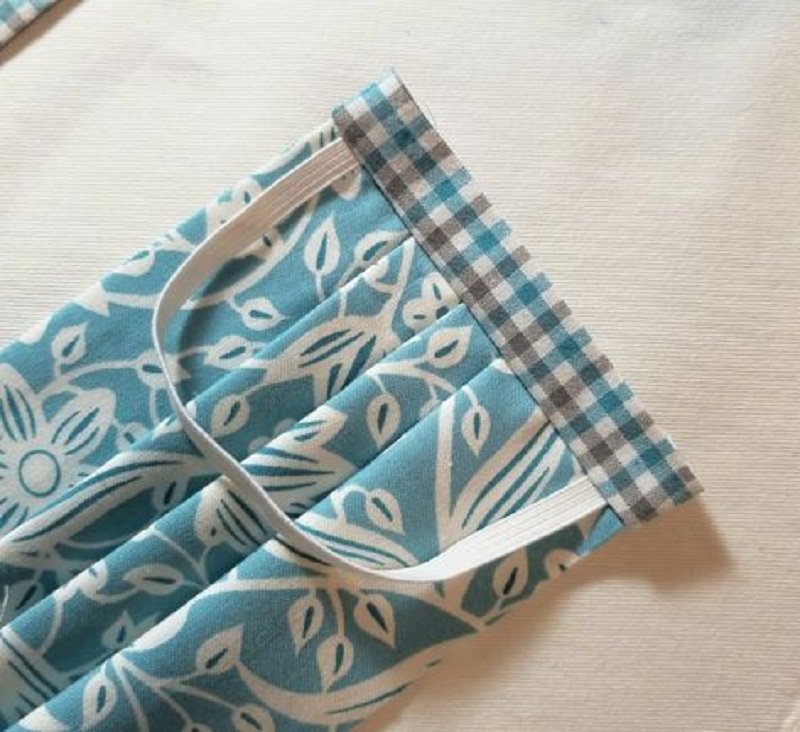

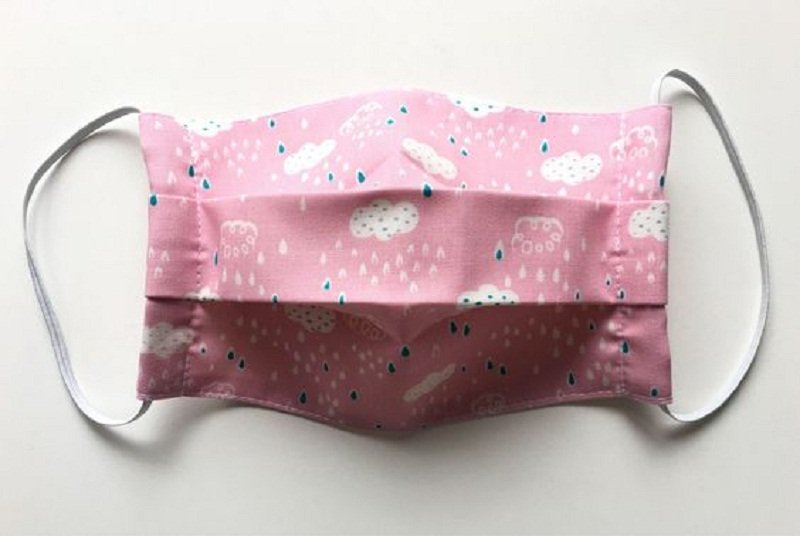
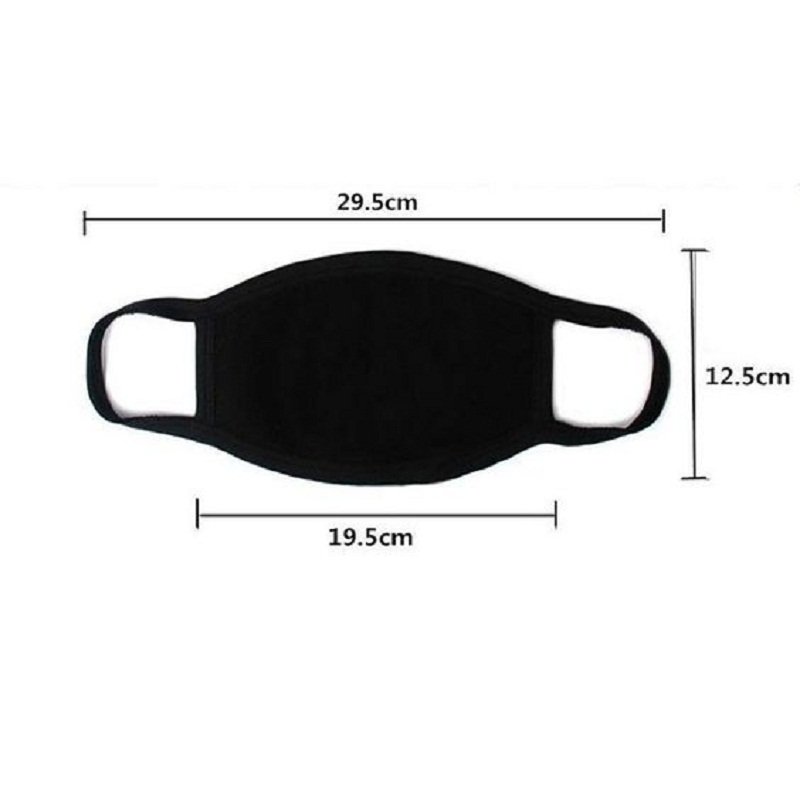
When to use a nasobuco or mask
If you are a healthy person, you only need to wear a mask if you care for someone suspected of carrying the virus.
Also wear a mask if you have a cough or sneeze.
Facemasks are only effective if combined with frequent hand washing.
Putting on and taking off a mask
Before you put on a mask, wash your hands thoroughly.
Cover your mouth and nose with the mask and make sure there are no gaps between your face and the mask.
Avoid touching the mask while you are wearing it.
To remove your mask: take it off from behind, without touching the front.
To reuse it, they recommend ironing it after washing it, as the virus cannot withstand high temperatures.
After handling a used mask, wash your hands immediately.
Cuba: 200 Cases of Leprosy Every Year

Cuba reports around 200 cases of leprosy every year, a disease that is well supervised and controlled on an outpatient basis
Many of the affected patients experience some form of discrimination and exclusion and therefore face mental health problems, such as depression or anxiety.
by Web Editor
January 29, 2020
Translated and edited by Walter Lippmann for CubaNews.
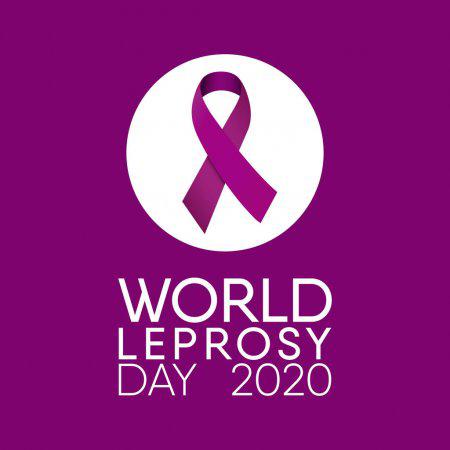
Many erroneous beliefs are related to leprosy, but specialists in the field prefer to point out three truths about it:. It is curable, it is not contagious because it ceases to be transmissible beginning with the first doses of treatment and it does not produce deformities or disability if it is diagnosed in time.
World Leprosy Day is observed on the last Sunday of January, this time on the 26th. Dr. Raisa Rumbaut Castillo, head of the National Leprosy Program of the Ministry of Public Health, explained that every year in Cuba an average of 200 new cases of both sexes are reported, from all provinces, mainly Granma, Santiago de Cuba, Camagüey, Ciego de Ávila and Havana, the latter because of the number of migrants it receives.
Many of the affected patients experience some kind of discrimination and exclusion and therefore face mental health problems, such as depression or anxiety. In view of this, this year’s theme will be: Stigma and human rights of people affected by leprosy.
The doctor stressed that unlike other countries where treatment is only supervised in the first dose, in Cuba leprosy patients receive free, supervised and controlled care (on an outpatient basis) in primary health care, that is, through the Family Doctor and Nurse Program. Patients are no longer isolated in sanatoriums (formerly called leprosaria).
The also First Degree specialist in Epidemiology and Master in Infectious Diseases said that this treatment is donated by the World Health Organization (WHO), which recently decreed that every January 30 (and from this year) will be commemorated the World Day for Neglected Tropical Diseases (WTD), which includes leprosy.
Apart from the fact that there is no neglected disease here, both dates will be remembered on 30 and 31 January with a national scientific day to be held in the capital, at the Comandante Manuel Fajardo University Clinical Surgical Hospital, which will be supported by the Cuban Dermatology Society.
Leprosy is a chronic disease that affects the peripheral nerves and the skin, but has no defined symptoms. This is why specialists call it a “great simulator”.
However, the most common symptoms are light patches of skin (brown and red), which may or may not have sensitivity disorders. That is to say, difficulties in differentiating the cold temperature from the hot one in the affected areas, as well as the loss of the sensation of pain.
The risk of contagion is very low and the incubation period, on average, is five years, but it can be as long as two years and as long as 20 years. The bacillus penetrates through the skin or the mucous membranes of the body and evolves slowly, progressively affecting the nervous system and the skin. This means that close and repeated contact with an untreated patient is required.
The first news of the disease in Cuba is dated January 17, 1613 and corresponds to the act of the Cabildo, when a group of neighbors from Havana, reported that “there are 4 or 6 people touched by the San Lazaro disease that have come from outside”. This document, of importance for the Medical History of Cuba, indicates the beginning of the leprosy endemic.
Every year, according to WHO data, around 200,000 new cases are diagnosed in the world, with India (more than 120,000 cases), Brazil (more than 28,000 cases) and Indonesia (more than 18,000 cases) being the nations with the greatest number of reports of the disease.
For years this organization has proposed to eliminate this disease. The goal was for each nation to achieve a prevalence rate of less than 1 case per 10,000 inhabitants. Cuba has been meeting this goal since 1993, and is now in the post-elimination phase.
“Behind a leprosy patient, there is always the one who infected them. That is why the most important thing is to interrupt transmission,” said the doctor.ef
Youth and Beauty At All Costs?

Youth and Beauty at All Costs?
Since 2011 there has been an increase in the number of people attending plastic surgery services in Cuba, who should be aware that this type of intervention is not without risks.
Posted: Saturday 29 September 2018 | 10:15:43 pm.
Author: Ana María Domínguez Cruz
digital@juventudrebelde.cu
A CubaNews translation.
Edited by Walter Lippmann.

Since 2011 many people have turned to plastic surgery services. Author: Falco Published: 29/09/2018 | 10:03 pm
Aesthetics and health. The debate is still endless because the search for beauty, beyond the superficial, can also be a guarantee of emotional health, psychological stability, high self-esteem and general well-being.
Plastic surgery professionals also work in the field of reconstructive surgery and caumatology, and say that in the first place the safety of the procedure and the training of the professionals who put it into practice should be paramount.
According to data released at the 2nd Congress of the Cuban Society of Plastic Surgery and Caumatology, held from September 5 to 7 on the Island, from 2001 to 2016, 309,469 plastic surgeries were performed in Cuba The majority (200,508) were aesthetic and the rest reconstructive.
They added that there is a considerable increase every year starting in 2011, which places us in line with the rest of the world, where each time the number of people who come or need this specialty grows.
Dr. Ariel C. Prada, a third-year resident in Plastic Surgery and Caumatology at the Hermanos Ameijeiras Clinical Surgical Hospital, recently arrived at the Multimedia Editorial Office of Juventud Rebelde to answer questions related to the discipline in the country, its potentialities and perspectives, as well as its risks and complications.
The professor instructor and editor of the magazine Cirugía Estética y Reparadora [Esthetic and Reparative Surgery] clarified not a few doubts of our readers -some teenagers and young people-, from whom we offer a selection.

Dr. Ariel C. Prada, third year resident in Plastic Surgery and Caumatology, Hospital Clínico Quirúrgico Hermanos Ameijeiras. Photo: Roberto Ruiz
Lissa: What are all the plastic surgery services that we can access for free?
Ariel C. Prada (ACP): You can access all plastic surgery services (including cosmetic surgery and reconstructive surgery) free of charge, after a medical assessment to determine whether or not you qualify for that intervention. There are procedures in which alloplastic materials are used (breast implants, buttocks, etc.) that in the case of cosmetic surgery must be acquired by the patient, having first the indication of its model and volume by the plastic surgeon.
Susel: Is it necessary to be of legal age to access an operation or is it only possible with the authorization of the legal guardian?
ACP: Like any medical-surgical procedure it has a legal background and risks. If you are a minor must have the approval of parents or legal guardians. We do not know the nature of the procedure you wish to be performed, but we always recommend that, if it is not strictly necessary, you wait until the age of majority, either to seek better aesthetic results or because they are purely elective surgical interventions (cosmetic surgery), not essential for your life. Remember that undergoing surgery, in this case, is a very personal decision that requires full awareness and maturity.
Hope: I want to remove the “crows feet”, a little fat from my belly, my neck wrinkles … How many cosmetic surgeries can a person do, and how long should you wait between one and another?
ACP: There is no specific number of cosmetic or reconstructive surgeries that can be performed on a person. Above all, it must be evaluated by a specialist, who will determine, according to his opinions, which is the best aesthetic option, according to factors as varied as the type of patient, age, basic diseases and magnitude of the procedure, among others.
“Our specialty is a complement to improve the quality of life of people. Thus, it in no way replaces healthy habits such as a good diet, avoiding toxic habits or frequent physical exercise. In fact, many times our intervention is not necessary or its magnitude decreases, with much better results. The patient must be aware and responsible for their own health, to have lifestyles that maintain the results of the procedure performed.
Yaima: I have black skin, am 52 years old… Does race influence this type of surgery?
ACP: In medicine, and particularly in plastic surgery and caumatology, one of the elements taken into account is the racial biotype. Age is also a factor that is considered depending on the patient’s desire.
Iris: How is the procedure so that a woman who was operated on a radical breast can have access to the reconstruction of this part of her body? Where should she go?
ACP: Surely you were seen in a center with oncology service. Your oncologist, after considering that you are free of the disease (at least for a year) can refer you to a reconstructive surgery service, either in an oncology hospital or clinical-surgical, to begin the process of breast reconstruction which can be done in several stages.
“The National Breast Cancer Program contemplates the free reconstruction of all women affected by this pathology, with quality and first-class breast implants in centers such as the National Institute of Oncology and Radiobiology (Havana), Hermanos Ameijeiras Clinical-Surgical Hospital (Havana) and Conrado Benítez Oncological Hospital (Santiago de Cuba). You should consult with your oncologist in which center, according to the regionalization of health services, you should be treated.
Carmen: Those of us in our third age can opt for simple procedures, such as, for example, one that allows us to lift our drooping eyelids?
ACP: Although there are “simple procedures”, all require the expertise, experience and “aesthetic vision” of a plastic surgeon. We mean that there are sick people, not diseases (an old medical adage). Therefore, each treatment must be individualized, because what a patient requests is not always the best aesthetic or technically possible option.
“In the elderly, we must take into account the compensation of their basic illnesses, because we are talking about purely elective procedures, in which the risk must be minimal and the benefit, the highest possible.
Yeny: What practices should a patient follow after having a lipectomy*? How long should she wait to perform physical exercises and which are the most recommended? Is it normal to feel punctures in the abdominal region two years after this type of surgery has been performed?
ACP: First of all, you must have followed the indications of the plastic surgeon who operated on you, because s/he knows the characteristics of the patient, the details of his procedure and therefore the limitations and possible evolution, among others.
“Generally, three months after the operation, as long as they have not been complex dermolipectomies, patients can gradually resume themselves into their lives fully, without excesses. Physical exercises should be dosed and increased progressively. Aerobes and any activity that tones the muscles improve the results of the procedure. Consult your surgeon about the symptomatology presented, because s/he will surely offer you a more exact explanation and a solution.
The returning breast
Surgeries do not replace healthy lifestyle habits, but they are a choice many make.
When we speak of plastic surgery, the term also includes reconstructive surgery, which guarantees not only an aesthetic result, but also the return of function to the affected area.
In this sense, Dr. Yamilé León Rodríguez, who works at Hermanos Ameijeiras Hospital, tells Juventud Rebelde that oncological, traumatic or congenital deformities in the face, in the breast due to cancer and ulcers in dissimilar parts of the body, among others, are treated in this way.
“We have a multi-disciplinary breast cancer care group that includes oncologists, mastólogos, radio-oncologists, imageologists, psychologists, psychiatrists and specialists in reconstructive plastic surgery, who enter the process after it has been decided how the ablative surgery of the patient will be conducted.
“The defect to be corrected may be in the breast, when a partial or total removal of an organ or body tissue is performed in a radical mastectomy, or to correct a defect that remains in the chest wall, as a result of an ablation of a large tumor.
“We have developed several techniques, including reconstruction with the local tissues of the breast, with muscles, especially the abdominal rectum and the broad dorsal, as well as through flaps obtained from the abdomen, or the novel technique applied in the country of the sentinel ganglion, which determines the degree of spread of cancer.
León Rodríguez points out that patients of different ages, from 18 to 85 years old, have been treated with this type of aesthetic reconstruction. “The results show that it is not mandatory to perform total exeresis and that the subsequent reconstruction, with or without the use of prostheses, gives the woman back one of the classic attributes of femininity”.
Perfect face!
Rhinoplasty is a complex but generally not life-threatening procedure.
Dr. Julio Cesar Galvez Chavez recognizes that in the desire to look younger, more and more patients come to his office. They should know that there are also selection criteria for cervicofacial rejuvenation surgeries.
“If there are signs of aging, then we can consider this type of surgery. We can find these elements in young people, perhaps because they have very white skin. In general, however, we perform them in patients over 40 years and up to 60, although the age limit is not as determinant as physical conditions and health.
“Many people believe that this is a magical intervention that will return them to the freshness they had at 15 years. This isn’t so, because, although it is guaranteed to make you look younger, you can’t turn back the clock.
The fundamental motivations for performing a surgery in the environment of cervicofacial rejuvenation are related to the fall of the eyebrows, the appearance of horizontal or transverse wrinkles in the eyebrows, the excess of skin on the eyelids and the appearance of fat pockets in that area, the loss of the contour of the jaw and the presence of the so-called marionette lines, the fall of the chin and the loss of angularity in the neck, among others.
Gálvez Chávez is also an expert in rhinoplasty, an aesthetic procedure indicated for those who wish to modify the size and shape of their nose as well as to improve their respiratory function in case of deformities in their septum.
“We perform reductive rhinoplasty in those noses of large dimensions and augmentative for flat or underdeveloped. In addition, we can make other procedures to model or perfect the features according to aesthetic patterns worldwide, either in the tip of the nose, the wings, the back, the nostrils and in general in all regions of the nose.
“Rhinoplasties are not recommended for people over 40 years of age because the skin’s ability to adapt to structural changes is important. This is most noticeable before the age of 30,” says the specialist, who notes that, although vital rules of care must be respected after rhinoplasty, it is not a life-threatening surgery.
Molding the body
How many people yearn for an aesthetic surgery after which they will look slim and slender? Dr. Heizel Escobar Vega, a specialist at the Hospital Clínico-Quirúrgico Hermanos Ameijeiras, states that this is the main reason why patients come to her practice. They ignore the fact that liposculpture is not a method for treating obesity.
“Liposculpture is the surgical treatment we perform to treat the areas of the body where fat deposits are found, such as the abdomen, the trochanteric regions and the arms, among others. Not only is it a question of removing those fat accumulations, but also of performing the lipo-injection in other areas in which they are desired.
“With this procedure, we obtain a corporal mold, as much in men as in women. Lately, they want to lose fat, in the abdomen and lumbar regions. They also request high definition surgery to obtain the well-known “squares”, an increased request also in recent times in the female population”.
Escobar Vega insists that not everyone can be a candidate for this surgical intervention. “We are rigorous in the selection of patients. Although people generally think that it is a simple surgery, due to the fact that it is among the most performed globally, it is certainly one of the riskiest and has the highest mortality associated with it, depending on the time and volume of fat extracted. Moreover, its realization leads to the modification of the metabolic, biochemical and hepatic mechanisms of the organism.
“Follow-up after surgery is essential, and the patient must respect the measures indicated by his attending physician.
Dr. María del Carmen Franco Mora is a specialist at the Juan Bruno Zayas General Hospital in Santiago de Cuba. She explains that the demand for gluteal lipo-injection has grown, a procedure that requires prior liposuction or liposculpture, from which the fat extracted is injected into that area of the body.
“The most frequent general complications are associated with the most feared, ranging from fatty and pulmonary thromboembolism, septic shock and severe anemias, to local infection and hematomas, among others.
“The criteria established for the classification of the patient must be very respected. We do not operate on people with a body mass index above 30 until they lose weight before, nor on those with a history of thrombotic diseases in lthe ower limbs or with the presence of varicose veins, nor on those who take oral contraceptives, among other exceptions”.
Subscribe to Blog via Email
| M | T | W | T | F | S | S |
|---|---|---|---|---|---|---|
| 1 | 2 | 3 | 4 | |||
| 5 | 6 | 7 | 8 | 9 | 10 | 11 |
| 12 | 13 | 14 | 15 | 16 | 17 | 18 |
| 19 | 20 | 21 | 22 | 23 | 24 | 25 |
| 26 | 27 | 28 | 29 | 30 | 31 | |

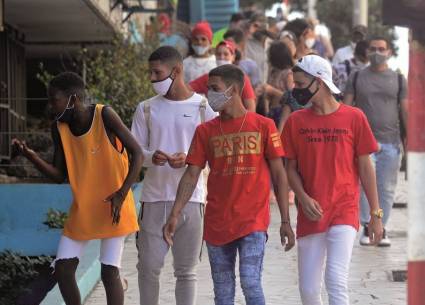
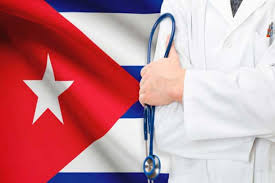



You must be logged in to post a comment.